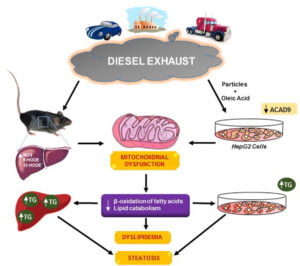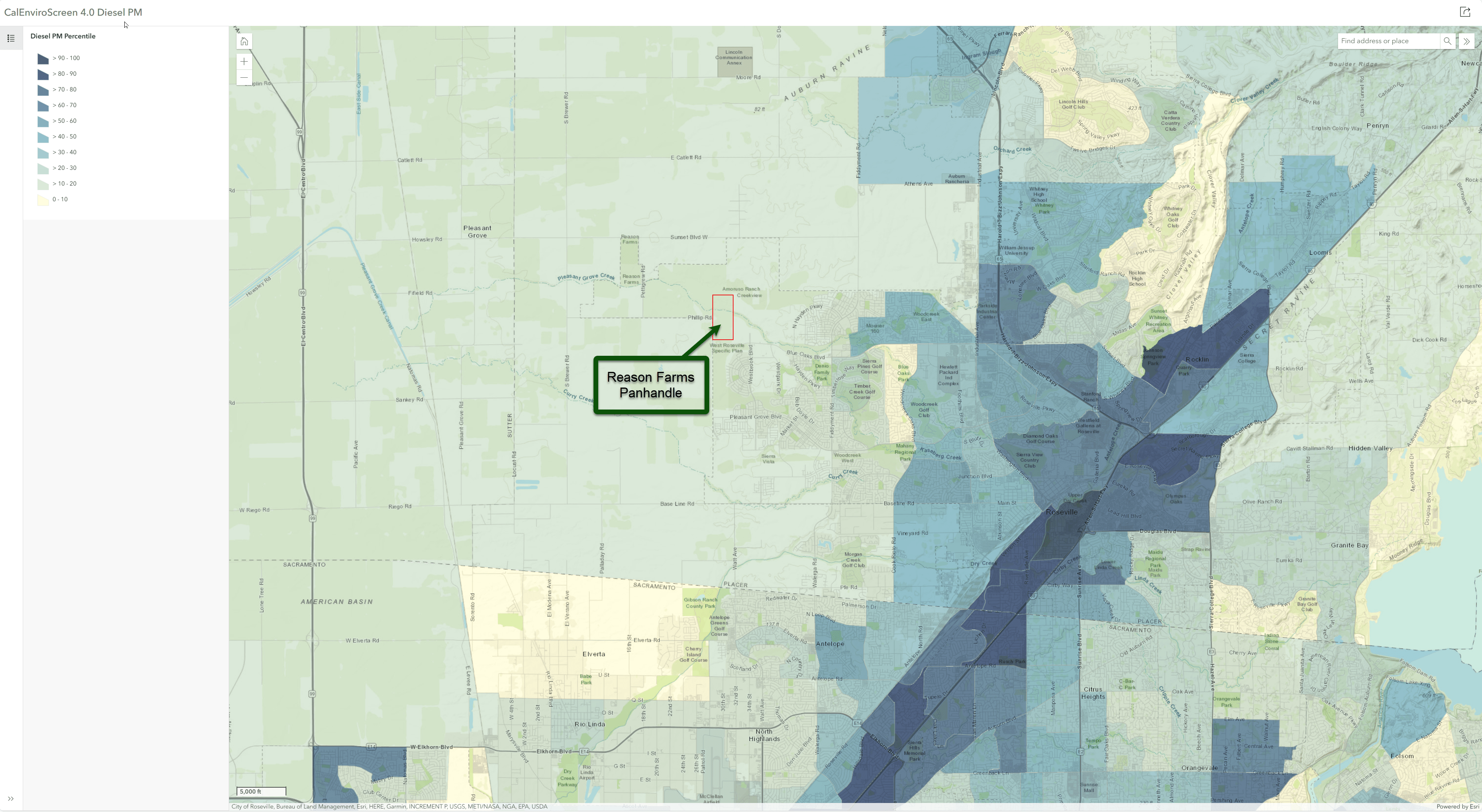Horrible pollution from diesel trucks

What is diesel exhaust?
Diesel exhaust is produced when an engine burns diesel fuel. It is a complex mixture of thousands of gases and fine particles (commonly known as soot) that contains more than 40 toxic air contaminants. These include many known or suspected cancer-causing substances, such as benzene, arsenic and formaldehyde. It also contains other harmful pollutants, including nitrogen oxides (a component of urban smog).
Air Pollution
Air pollution is associated with increased cardiovascular morbidity and mortality (i.e. death), as well as dyslipidemia and metabolic syndrome.
-
Diesel exhaust induces mitochondrial dysfunction, hyperlipidemia, hypertriglyceridemia, hypercholesterolemia, and liver steatosis.
-
Diesel exhaust alters lipid and carbohydrate metabolism.
- Development of hepatic steatosis is likely due to mitochondrial dysfunction in the liver.
Reference: Arteriosclerosis, Thrombosis, and Vascular Biology, Vol. 39, No. 9, Diesel Exhaust Induces Mitochondrial Dysfunction, Hyperlipidemia, and Liver Steatosis
How are people exposed to diesel exhaust?
Diesel exhaust particles and gases are suspended in the air, so exposure to this pollutant occurs whenever a person breathes air that contains these substances. The prevalence of diesel-powered engines makes it almost impossible to avoid exposure to diesel exhaust or its byproducts, regardless of whether you live in a rural or urban setting. However, people living and working in urban and industrial areas are more likely to be exposed to this pollutant. Those spending time on or near roads and freeways, truck loading and unloading operations, operating diesel-powered machinery or Health effects of Diesel Exhaust. A fact sheet by Cal/EPA’s Office of Environmental Health Hazard Assessment and The American Lung Association of California working near diesel equipment face exposure to higher levels of diesel exhaust and face higher health risks.
What are the health effects of diesel exhaust?
As we breathe, the toxic gases and small particles of diesel exhaust are drawn into the lungs. The microscopic particles in diesel exhaust are less than one-fifth the thickness of a human hair and are small enough to penetrate deep into the lungs, where they contribute to a range of health problems.
Diesel exhaust and many individual substances contained in it (including arsenic, benzene, formaldehyde and nickel) have the potential to contribute to mutations in cells that can lead to cancer. In fact, long-term exposure to diesel increases the risk of exhaust particles poses the highest cancer risk of any toxic air contaminant evaluated by the California Environmental Protection Agency’s Office of Environmental Health Hazard Assessment (OEHHA).
The California Air Resources Board (ARB) estimates that about 70 percent of the cancer risk that the average Californian faces from breathing toxic air pollutants stems from diesel exhaust particles. In its comprehensive assessment of diesel exhaust, OEHHA analyzed more than 30 studies of people who worked around diesel equipment, including truck drivers, railroad workers and equipment operators. The studies showed these workers were more likely to develop lung cancer than workers who were not exposed to diesel emissions. These studies provide strong evidence that long-term occupational exposure to diesel exhaust increases the risk of lung cancer. Using information from OEHHA’s assessment, ARB estimates that diesel-particle levels measured in California’s air in 2000 could cause 540 “excess” cancers (beyond what would occur if there were no diesel particles in the air) in a population of 1 million people over a 70-year lifetime. Other researchers and scientific organizations, including the National Institute for Occupational Safety and Health, have calculated cancer risks from diesel exhaust that are similar to those developed by OEHHA and ARB.
Diesel Particulate Matter
According to the California Office of Environmental Health Hazard Assessment (OEHHA):
“Exhaust from trucks, buses, trains, ships, and other equipment with diesel engines contains a mixture of gases and solid particles. These solid particles are known as diesel particulate matter (diesel PM). Diesel PM contains hundreds of different chemicals. Many of these are harmful to health. The highest levels of diesel PM are near ports, rail yards and freeways. People are exposed to diesel PM from breathing air containing diesel exhaust.”
- People living and working in cities and industrial areas and near heavy truck or train traffic are most likely to come in contact with diesel PM.
- The very small particles of diesel PM can reach deep into the lung, where they can contribute to a range of health problems. These include irritation to the eyes, throat and nose, heart and lung disease, and lung cancer.
- Children and the elderly are especially vulnerable to the effects of diesel PM.
How is diesel particulate matter measured in CalEnviroScreen 4.0?
- The California Air Resources Board (CARB) collects estimates of diesel PM emissions from many sources.
- The indicator uses CARB data on emissions from on-road (trucks and buses) and off-road (ships and trains, for example) sources.
- Diesel emissions are available at a 1x1km grid statewide. The gridded emissions are converted to census tracts.
- Adjustments to diesel PM emissions from idling trucks in Mexico at the U.S. border crossings were also accounted for.
A complete description of the Diesel PM indicator can be found in the CalEnviroScreen 4.0 report.
Exposure to diesel exhaust can have immediate health effects. Diesel exhaust can irritate the eyes, nose, throat and lungs, and it can cause coughs, headaches, light-headedness and nausea. In studies with human volunteers, diesel exhaust particles made people with allergies more susceptible to the materials to which they are allergic, such as dust and pollen. Exposure to diesel exhaust also causes inflammation in the lungs, which may aggravate chronic respiratory symptoms and increase the frequency or intensity of asthma attacks.
Exposure to diesel exhaust also causes inflammation in the lungs, which may aggravate chronic respiratory symptoms and increase the frequency or intensity of asthma attacks. Diesel engines are a major source of fine-particle pollution. The elderly and people with emphysema, asthma, and chronic heart and lung disease are especially sensitive to fine-particle pollution. Numerous studies have linked elevated particle levels in the air to increased hospital admissions, emergency room visits, asthma attacks and premature deaths among those suffering from respiratory problems. Because children’s lungs and respiratory systems are still developing, they are also more susceptible than healthy adults to fine particles. Exposure to fine particles is associated with increased frequency of childhood illnesses and can also reduce lung function in children.
Diesel engines produce nitrogen oxides — an air pollutant. Nitrogen oxides can damage lung tissue, lower the body’s resistance to respiratory infection and worsen chronic lung diseases, such as asthma. They also react with other pollutants in the atmosphere to form ozone, a major component of smog.
Source: California Office of Environmental Health Hazard Assessment
Source: CalEnviroScreen 4.0 Diesel PM
For the excellent reasons set forth above, Roseville residents aim to protect and preserve the Phillip Road Site.

